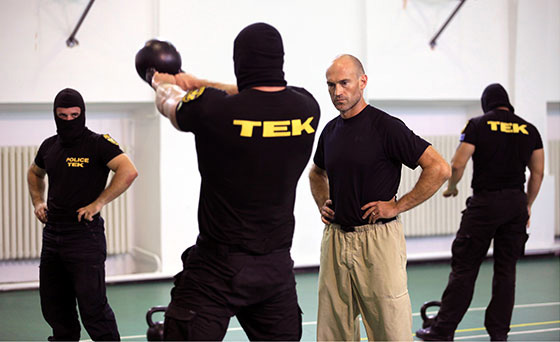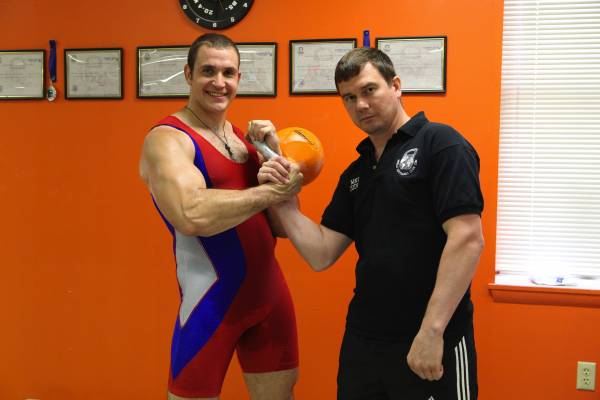Today I received the following question on our Facebook Group:
“Nate, would love to know your thoughts on Hard Style KBs vis-a-vis GS KBs for building transferable strength for everyday hard living as well as sport.”
Well, I am uniquely qualified to answer that question for several reasons. For one, I was one of the first eight Senior RKC Instructors who introduced the RKC “Hard Style” of kettlebell lifting to the world. I was also the first American to travel to Russia to train with Russian coaches in Girevoy Sport. I must point out that prior to my trip, Steve Cotter traveled to Russia to compete in Girevoy Sport, but not to train specifically. I am also a coach who has transcended these doctrines to a place I think is far more useful than the strict adherence most sycophants display regarding any particular lifting “style.”
Before I begin spreading hate and discontent, let me first assure you that I love kettlebells. In fact, I may never again pick up another barbell again. Let me also say that I soured on kettlebells for a good while and tried to build a case against them. I failed so completely that I now insist on using little more than kettlebells for myself and any of my clients. I have a lot of very specific reasons for this which I will publish another time. Now for the part where I piss off half the planet…
I’ll begin with the Russian Kettlebell Challenge (RKC), aka, “Hard Style.” The first thing you need to understand is that the term “Hard Style” was not originally a part of the Russian Kettlebell Challenge (RKC) training, namesake or marketing. It was rolled out when it was revealed by Valery Fedorenko and others that what Pavel Tsatsouline was teaching was not at all the way kettlebells were used in Russia. In response, Pavel and Dragon Door Publications responded with, ‘oh no, of course not. This is “hard style” and it’s our own little thing that’s different and better.’
The big question was, better for what? What was this “hard style” good for? In my experience, very little. It’s good to get people who are hypermobile to tighten up. It’s good for teaching some basics of movement when people lack the required inter-muscular coordination to move properly under control. It’s good for maximal load, low rep lifting, which is where all of this silliness came from in the first place.
Pavel simply took concepts used by powerlifters and applied them to kettlebell lifts he was familiar with. He had not been trained in kettlebell sport lifting and he sure as hell wasn’t a Master of Sport in kettlebell lifting. Not that one has to be, but very little of what he taught was/is true to the sport or traditional use of kettlebells. Between that and the lies about being a Master of Sport, he is universally hated throughout Russia. Basically, all that RKC/Hard Style is good for is a small amount of general fitness training. Those who adopt it as a majority of their training suffer greatly from excessive muscular tension disorders, poor breathing patterns and a lack of stamina and flexibility. It’s not particularly useful for athletes unless they are strength athletes.
Then there is Girevoy Sport (GS, also called kettlebell sport). GS is a very interesting sport and the training is as fascinating as it is brutal. GC athletes are the undisputed masters of muscular endurance. With that endurance also comes massive strength. But is GS good for athletes? No, not especially. It can be very useful but the devil is in the details. GS is only three events: Snatch, Jerk, and Long Cycle Clean & Jerk. Even though these exercises are excellent and the strength and strength-stamina gained is outstanding, it’s specific to GS and not other sports. So no, GS is also not particularly useful for athletes unless they are GS athletes.
And yet, that’s not the end of the story at all. Because as thoroughly worthless as RKC is, there are a few principles they use that are of some value, especially if you happen to be lifting heavy loads. Likewise, while GS produces shocking GS performances, that capability is of little to no value to other athletes. However, GS training principles and methods are crammed full of some of the most epic training information you will ever find! I should also mention, for the sake of completeness, that RKC is a relatively low skill activity, while GS is a very high skill activity.
So where does that leave the answer to the question? To do it justice I have to answer it with several answers.
- Neither RKC or GS are of any real use to athletes. The execution of their primary and accessory exercises simply does not transfer to other sports and GS is of little use to those seeking to look better naked.
- RKC uses some principles from the powerlifting world that are of use with new general fitness clients or for anyone lifting heavy loads for low reps.
- GS is crammed full of amazing principles and methods of training that are of great use to athletes and of little use to the general fitness crowd. However, the three exercises used in competition are of limited value to athletes when performed for the duration and at the technical skill level demonstrated by the average GS athlete.
- There is another way to look at the issue…
It turns out that the Kettlebell is just a tool and how you use the tool makes all the difference. What I discovered was that the kettlebell, when confined to RKC or GS was honestly a little boring and underwhelming. However, I then discovered the real secret of the kettlebell. Some of it was contained in Soviet manuals I own and some of it was my own discovery. Those discoveries are as follows:
- In accordance with classical physical education, kettlebell lifting of all kinds is object manipulation.
- The kettlebell can be used/manipulated in almost every rudimentary (aka primal) movement pattern.
- It can be used in these patterns cyclically and acyclically depending on the weight.
- It can be used as above to train all three energy systems and all nine pathways.
- It is easily combined with body control drills.
- It can be used to train a massive variety of biomotor abilities in most general and specific preparation programs.
- It is significantly less damaging to the joints than barbell lifting.
- It is significantly more effective than dumbbell lifting in most lifts.
- It is significantly safer than barbell training, especially at higher loads.
- One can build far greater functional strength, stamina, speed, coordination, and flexibility with kettlebells over all other implements with the exception of some SPP drills for particular sports.
Practically speaking, this means if you treat kettlebells the same as any other weight/tool and choose your exercises, variables, and progressions properly, you get way more bang for the buck with kettlebells than a million dollar’s worth of fancy equipment. To hell with these “styles,” use the best tool the best way you know how. I don’t use RKC or GS and I have no interest in either. I use the right training principle to meet the client’s requirements; it’s just that a couple came from RKC and a metric ton of them came from GS. That’s what sets us apart from everyone else. Everything we do is principle based, not technique based. This gives us the flexibility and adaptability required to address the specific needs of our clients to produce the high levels of performance we routinely achieve.
Death to the kettlebell! Long live the kettlebell!
*The views and opinions expressed on this website are solely those of the original authors and contributors. These views and opinions do not necessarily represent those of Spotter Up Magazine, the administrative staff, and/or any/all contributors to this site.

